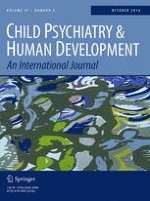Introduction
The Factor Structure of Inventory of Callous-Unemotional Traits
Validity of the (Short-Form) Inventory of Callous-Unemotional Traits
Validating the (Short-Form) Inventory of Callous-Unemotional Traits in Females1
Current Study
Hypotheses
Methods
Participants
Procedure
Measures
Inventory of Callous-Unemotional Traits (ICU)
Youth Psychopathic Traits Inventory (YPI)
Youth Self-Report (YSR)
Diagnostic Interview Schedule for Children-Fourth Version (DISC-IV)
Quick Big Five (QBF)
Self-Reported Offending
Socio-demographics
Analytic Strategy
Results
Factor Structure of the ICU and Short-Form ICU
Descriptive Statistics and Reliability Estimates
Current sample | |||||||
|---|---|---|---|---|---|---|---|
Mean | SD | Min, max | Theo. range | Alpha | MIC | MCITC | |
Original ICU
| |||||||
Total score | 27.73 | 10.25 | 3–57 | 0–72 | 0.79 | 0.14 | 0.34 |
Callousness subscale | 9.42 | 6.09 | 0–30 | 0–33 | 0.78 | 0.25 | 0.43 |
Uncaring subscale | 10.23 | 5.22 | 0–21 | 0–24 | 0.78 | 0.32 | 0.59 |
Unemotional subscale | 8.07 | 3.18 | 0–15 | 0–15 | 0.52 | 0.18 | 0.30 |
Short-form ICU
| |||||||
Total score | 9.14 | 5.88 | 0–25 | 0–33 | 0.76 | 0.22 | 0.41 |
Callousness subscale | 4.83 | 4.22 | 0–21 | 0–21 | 0.72 | 0.40 | 0.46 |
Uncaring subscale | 4.31 | 3.05 | 0–12 | 0–12 | 0.74 | 0.29 | 0.51 |
Criterion Validity
YPI | ||||
|---|---|---|---|---|
Callous-Unemotional | Grandiose-manipulative | Impulsive-irresponsible | Total | |
Original ICU
| ||||
Total score | .60** | .33** | .36** | .51** |
Callousness subscale | .57** (.51**) | .31** (.28**) | .35** (.32**) | .48** (.43**) |
Uncaring subscale | .34** (.20*) | .20* (.14) | .23* (.17) | .30** (.20*) |
Unemotional subscale | .29** (.13) | .14 (.04) | .12 (.00) | .21* (.06**) |
Short-form ICU
| ||||
Total score | .62** | .31** | .33** | .49** |
Callousness subscale | .52** (.42**) | .24* (.17) | .30** (.25*) | .41** (.33**) |
Uncaring subscale | .48** (.36**) | .27** (.22*) | .23* (.16) | .38** (.29**) |
Convergent Validity2
Psychopathic Traits: Grandiose-Manipulative and Impulsive-Irresponsible Traits
Psychiatric Disorders
ADHD | ODD | CD | CoCD | AoCD | SUD | |
|---|---|---|---|---|---|---|
Original ICU
| ||||||
Total score | 1.03 | 1.05* | 1.07** | 1.09** | 1.01 | 1.03 |
Callousness subscale | 1.04 (1.03) | 1.06 (1.05) | 1.09* (1.08*) | 1.07 (1.05) | 1.03 (1.03) | 1.04 (1.03) |
Uncaring subscale | 1.08 (1.08) | 1.10* (1.10*) | 1.13** (1.13*) | 1.20** (1.18**) | 1.00 (1.00) | 1.06 (1.05) |
Unemotional subscale | 1.01 (0.96) | 1.04 (0.97) | 1.04 (0.96) | 1.13 (1.03) | 0.96 (0.95) | 1.03 (0.98) |
Short-form ICU
| ||||||
Total score | 1.05 | 1.10* | 1.12** | 1.12** | 1.01 | 1.06 |
Callousness subscale | 1.05 (1.03) | 1.09 (1.06) | 1.11* (1.07) | 1.08 (1.02) | 1.03 (1.04) | 1.07 (1.05) |
Uncaring subscale | 1.11 (1.09) | 1.19* (1.16*) | 1.23** (1.20*) | 1.35** (1.33**) | 0.99 (0.98) | 1.08 (1.06) |
Externalizing Problems
Rule- breaking | Aggressive behavior | Attention problems | Violent offenses | Theft | Vandalism | Threats Insults | Drug offenses | Agreeableness | Conscien tiousness | |
|---|---|---|---|---|---|---|---|---|---|---|
Original ICU
| ||||||||||
Total score | .34** | .43** | .28** | .31** | .30** | .45** | .31** | .17 | −.43** | −.39** |
Callousness subscale | .31** (.28**) | .35** (.29**) | .28** (.25*) | .21* (.16) | .26** (.22*) | .34** (.28**) | .24* (.19*) | .13 (.10) | −.16 (−.06) | −.15 (−.05) |
Uncaring subscale | .24* (.19) | .37** (.32**) | .19 (.15) | .29** (.25*) | .22* (.17) | .36** (.30**) | .24* (.19) | .16 (.14) | −.45** (−.37**) | −.40** (−.32**) |
Unemotional subscale | .10 (−.01) | .13 (−.03) | .07 (−.03) | .13 (.02) | .12 (.02) | .19* (.04) | .15 (.05) | .06 (−.01) | −.33** (−.19*) | −32** (−.20*) |
Short-form ICU
| ||||||||||
Total score | .31** | .41** | .22* | .32** | .32** | .43** | .32** | .20* | −.34** | −26** |
Callousness subscale | .29** (.25*) | .33** (.25*) | .23* (.22*) | .20* (.11) | .25* (.18) | .32** (.22*) | .25** (.19*) | .14 (.09) | −.19* (−.08) | −.13 (−.04) |
Uncaring subscale | .21* (.13) | .34** (.27**) | .11 (.04) | .33** (.30**) | .28** (.23*) | .40** (.33**) | .27** (.22*) | .19* (.16) | −.40** (−.37**) | −.33** (−.32**) |
Self-Reported Offending
Big Five Personality
Exploring Relations With Internalizing Disorders and Problems
Affective disorder(s) | Anxiety disorder(s) | Anxious-Depressed | Withdrawn-Depressed | |
|---|---|---|---|---|
OR | OR | β | β | |
Original ICU
| ||||
Total score | 0.97 | 0.98 | −.23* | .08 |
Callousness subscale | 0.97 (0.98) | 1.00 (1.01) | −.04 (.01) | .12 (.12) |
Uncaring subscale | 0.94 (0.95) | 0.93 (0.92*) | −.36** (−.38**) | −08 (−.17) |
Unemotional subscale | 0.95 (0.99) | 1.00 (1.05) | −.06 (.07) | .17 (.20) |
Short-form ICU
| ||||
Total score | 0.95 | 0.97 | −.23* | .02 |
Callousness subscale | 0.96 (0.99) | 1.00 (1.03) | −.04 (.08) | .10 (.14) |
Uncaring subscale | 0.88 (0.89) | 0.87* (0.86*) | −.39** (−.42**) | −.09 (−.13) |
